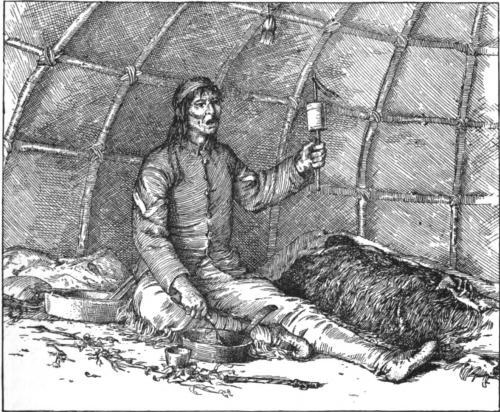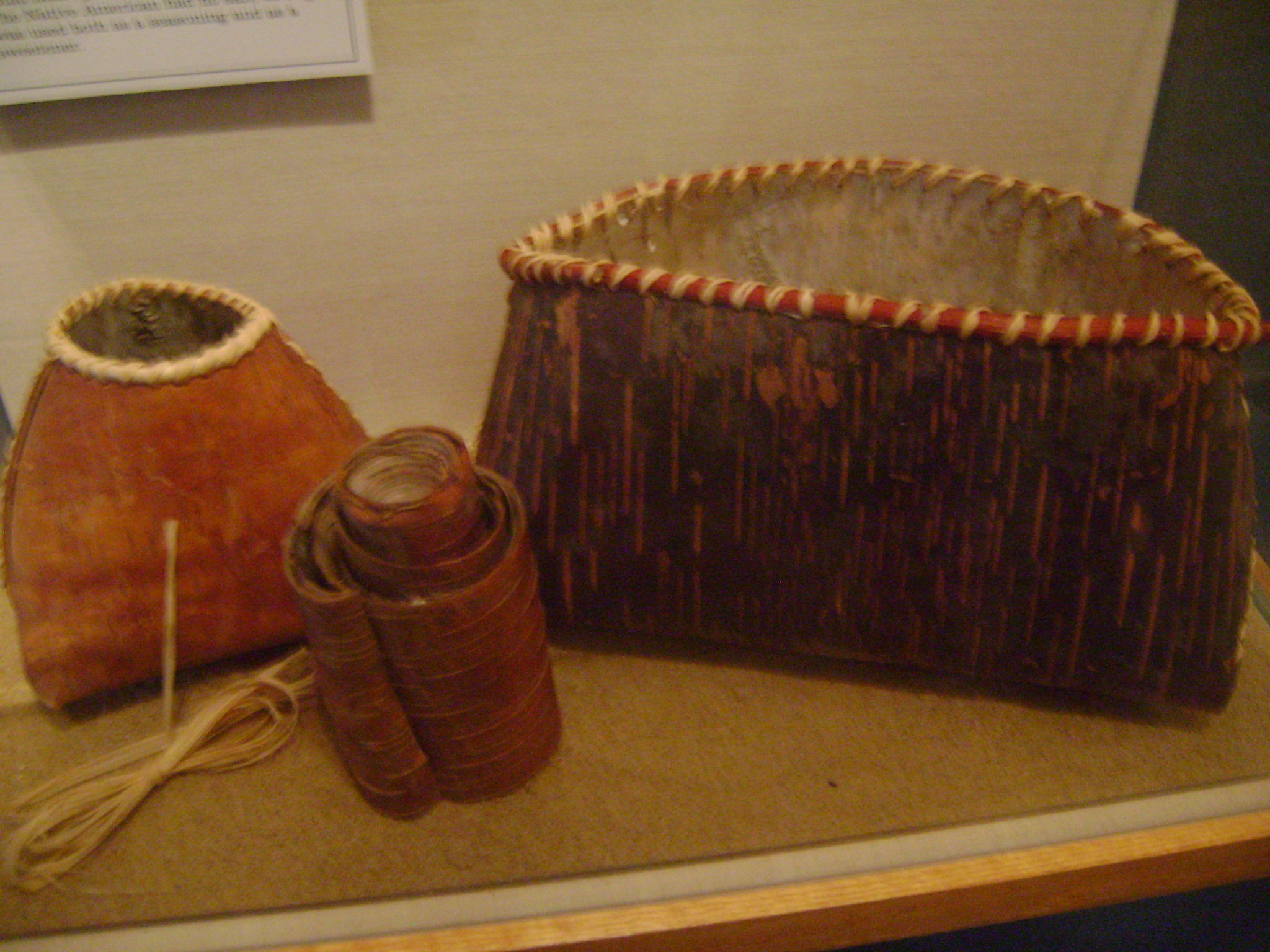|
Wiigwaasabak
A ''wiigwaasabak'' (in Ojibwe syllabics, Anishinaabe syllabics: , plural: ''wiigwaasabakoon'' ) is a birch bark scroll, on which the Ojibwa (Anishinaabe) people of North America wrote with a Ojibwe writing systems#Anishinaabewibii'iganan, written language composed of complex geometrical patterns and shapes. When used specifically for Midewiwin ceremonial use, these scrolls are called ''mide-wiigwaas'' (in syllabics: ). These enabled the memorization of complex ideas, and passing along history and stories to succeeding generations. Several such scrolls are in museums, including one on display at the Smithsonian Museum in Washington, DC. Copper and slate may have also been used, along with hides, pottery, and other artifacts. Some archaeologists are presently trying to determine the exact origins, dates, and locations of their use. Many scrolls were hidden away in caves and man-made pits. Construct The Birch bark, bark of the paper birch tree provides an excellent writing mater ... [...More Info...] [...Related Items...] OR: [Wikipedia] [Google] [Baidu] |
Midewiwin
The Midewiwin (in Ojibwe syllabics, syllabics: , also spelled ''Midewin'' and ''Medewiwin'') or the Grand Medicine Society is a religious society of some of the Indigenous peoples of the Maritimes, New England and Great Lakes regions in North America. Its practitioners are called ''Midew'', and the practices of ''Midewiwin'' are referred to as ''Mide''. Occasionally, male ''Midew'' is called ''Midewinini'', which is sometimes translated into English as "medicine man". Etymology Due to the body-part medial ''de meaning 'heart' in the Anishinaabe language, ''Midewiwin'' is sometimes translated as 'The Way of the Heart'. Minnesota archaeologist Fred K. Blessing shares a definition he received from Thomas Shingobe, a ''Mida'' (a ''Midewiwin'' person) of the Mille Lacs Indian Reservation in 1969, who told him that "the only thing that would be acceptable in any way as an interpretation of 'Mide' would be 'Spiritual Mystery'." Fluent speakers of Anishinaabemowin often caution that man ... [...More Info...] [...Related Items...] OR: [Wikipedia] [Google] [Baidu] |
Ojibwe Syllabics
Ojibwe The Ojibwe (; Ojibwe writing systems#Ojibwe syllabics, syll.: ᐅᒋᐺ; plural: ''Ojibweg'' ᐅᒋᐺᒃ) are an Anishinaabe people whose homeland (''Ojibwewaki'' ᐅᒋᐺᐘᑭ) covers much of the Great Lakes region and the Great Plains, n ... is an Indigenous languages of the Americas, indigenous language of North America from the Algonquian languages, Algonquian language family. Ojibwe is one of the largest Native American languages north of Mexico in terms of number of speakers and is characterized by a series of dialects, some of which differ significantly. The dialects of Ojibwe are spoken in Canada from southwestern Quebec, through Ontario, Manitoba and parts of Saskatchewan, with outlying communities in Alberta and British Columbia,Nichols, John, 1980, pp. 1-2 and in the United States from Michigan through Wisconsin and Minnesota, with a number of communities in North Dakota and Montana, as well as migrant groups in Kansas and Oklahoma. The absence of li ... [...More Info...] [...Related Items...] OR: [Wikipedia] [Google] [Baidu] |
Wiigwaasi-makak
A wiigwaasi-makak (plural: ''wiigwaasi-makakoon''), meaning "birch-bark box" in the Anishinaabe language, is a box made of panels of birchbark sewn together with watap. The construction of ''makakoon'' from birchbark was an essential element in the culture of the Anishinaabe people and other members of the Native Americans and First Nations of the Upper Great Lakes, particularly in the regions surrounding Lake Superior. Birchbark ''makakoon'' continue to be crafted to this day as heritage heirlooms and for the tourist trade. Lake Superior-area geology is short in supplies of clay, making pottery scarce for the people who lived there. However, the paper birch grows in profusion in this area, and sheets and panels of its strong, papery bark can be cut and carved from a tree for use. Birchbark boxes played a key role in creating durable packages and utensils for storage and everyday use. Skilled harvesting of the bark, done at the proper season of the year, does not fatall ... [...More Info...] [...Related Items...] OR: [Wikipedia] [Google] [Baidu] |
Anishinaabe
The Anishinaabe (alternatively spelled Anishinabe, Anicinape, Nishnaabe, Neshnabé, Anishinaabeg, Anishinabek, Aanishnaabe) are a group of culturally related Indigenous peoples of the Americas, Indigenous peoples in the Great Lakes region of Canada and the United States. They include the Ojibwe (including Saulteaux and Oji-Cree), Odawa, Potawatomi, Mississaugas, Nipissing First Nation, Nipissing, and Algonquin peoples. The Anishinaabe speak , or Anishinaabe languages that belong to the Algonquian languages, Algonquian language family. At the time of first contact (anthropology), first contact with Europeans they lived in the Indigenous peoples of the Northeastern Woodlands, Northeast Woodlands and the Indigenous peoples of the Subarctic, Subarctic, and some have since spread to the Plains Indians, Great Plains. The word means . Another definition is , meaning those who are on the right road or path given to them by the Creator deity, Creator Gitche Manitou, or Great Spirit. B ... [...More Info...] [...Related Items...] OR: [Wikipedia] [Google] [Baidu] |
Ojibwe Writing Systems
Ojibwe language, Ojibwe is an Indigenous languages of the Americas, indigenous language of North America from the Algonquian languages, Algonquian language family. Ojibwe is one of the largest Native American languages north of Mexico in terms of number of speakers and is characterized by a series of dialects, some of which differ significantly. The dialects of Ojibwe are spoken in Canada from southwestern Quebec, through Ontario, Manitoba and parts of Saskatchewan, with outlying communities in Alberta and British Columbia,Nichols, John, 1980, pp. 1-2 and in the United States from Michigan through Wisconsin and Minnesota, with a number of communities in North Dakota and Montana, as well as migrant groups in Kansas and Oklahoma. The absence of linguistic or political unity among Ojibwe, Ojibwe-speaking groups is associated with the relative autonomy of the regional dialects of Ojibwe. There is no single dialect that is considered the most prestigious or most prominent, and no st ... [...More Info...] [...Related Items...] OR: [Wikipedia] [Google] [Baidu] |
Legendary Creature
A legendary creature is a type of extraordinary or supernatural being that is described in folklore (including myths and legends), and may be featured in historical accounts before modernity, but has not been scientifically shown to exist. In the classical era, monstrous creatures such as the Cyclops and the Minotaur appear in heroic tales for the protagonist to destroy. Other creatures, such as the unicorn, were claimed in accounts of natural history by various scholars of antiquity. Some legendary creatures are Hybrid beasts in folklore, hybrid beasts. Some legendary creatures originated in traditional mythology and were believed to be real creatures--for example, dragons, griffins and unicorns. Others are based on real encounters or garbled accounts of travellers' tales, such as the Vegetable Lamb of Tartary, a sheeplike animal which supposedly grew tethered to the earth. Creatures A variety of mythical animals appear in the art and stories of the classical era. For exampl ... [...More Info...] [...Related Items...] OR: [Wikipedia] [Google] [Baidu] |
Whiteshell Provincial Park
Whiteshell Provincial Park is a provincial park in southeast Manitoba, approximately east of the city of Winnipeg. The park is considered to be a IUCN protected area categories#Category II — National Park, Class II protected area under the IUCN protected area management categories. It is in size. The park protects areas representative of the Lake of the Woods Ecoregion within the Boreal Shield Ecozone (CEC), Boreal Shield ecozone. The park's protection also specifically extends to the Tie Creek basin, an area of great spiritual significance to Indigenous peoples. History Whiteshell Provincial Park was designated a provincial park by the Government of Manitoba in 1961. It was one of the first group of parks established the year following the passage of the Manitoba Provincial Parks Act. Tourism interest in the area had begun shortly after the arrival of railway lines—the Canadian Pacific Railway in 1883 and the Canadian Northern Railway around 1908. In 1927, the area ... [...More Info...] [...Related Items...] OR: [Wikipedia] [Google] [Baidu] |
Ice Age
An ice age is a long period of reduction in the temperature of Earth's surface and atmosphere, resulting in the presence or expansion of continental and polar ice sheets and alpine glaciers. Earth's climate alternates between ice ages, and greenhouse periods during which there are no glaciers on the planet. Earth is currently in the ice age called Quaternary glaciation. Individual pulses of cold climate within an ice age are termed '' glacial periods'' (''glacials, glaciations, glacial stages, stadials, stades'', or colloquially, ''ice ages''), and intermittent warm periods within an ice age are called '' interglacials'' or ''interstadials''. In glaciology, the term ''ice age'' is defined by the presence of extensive ice sheets in the northern and southern hemispheres. By this definition, the current Holocene epoch is an interglacial period of an ice age. The accumulation of anthropogenic greenhouse gases is projected to delay the next glacial period. History of research ... [...More Info...] [...Related Items...] OR: [Wikipedia] [Google] [Baidu] |
Animal
Animals are multicellular, eukaryotic organisms in the Biology, biological Kingdom (biology), kingdom Animalia (). With few exceptions, animals heterotroph, consume organic material, Cellular respiration#Aerobic respiration, breathe oxygen, have myocytes and are motility, able to move, can reproduce sexually, and grow from a hollow sphere of Cell (biology), cells, the blastula, during embryonic development. Animals form a clade, meaning that they arose from a single common ancestor. Over 1.5 million extant taxon, living animal species have been species description, described, of which around 1.05 million are insects, over 85,000 are molluscs, and around 65,000 are vertebrates. It has been estimated there are as many as 7.77 million animal species on Earth. Animal body lengths range from to . They have complex ecologies and biological interaction, interactions with each other and their environments, forming intricate food webs. The scientific study of animals is known as ... [...More Info...] [...Related Items...] OR: [Wikipedia] [Google] [Baidu] |
Mazinibaganjigan
Birchbark biting (Ojibwe: Mazinibaganjigan, plural: mazinibaganjiganan) is an Indigenous artform made by Anishinaabeg, including Ojibwe people,Indigenous Perspectives of North America: A Collection of Studies'. Cambridge Scholars Publishing; 20 August 2014. . p. 210–. Potawatomi, and Odawa, as well as CreeNative American Almanac: More Than 50,000 Years of the Cultures and Histories of Indigenous Peoples'. Visible Ink Press; 18 April 2016. . p. 1273–. and other Algonquian peoples of the Subarctic and Great Lakes regions of Canada and the United States. Artists bite on small pieces of folded birch bark to form intricate designs. Indigenous artists used birchbark biting for entertaining in storytelling and to create patterns for quillwork and other art forms. In the 17th century, Jesuits sent samples of this artform to Europe, where it had been previously unknown. The practice remained common in Saskatchewan into the 1950s. Name Birchbark biting is also known as ''mazinashkwemaga ... [...More Info...] [...Related Items...] OR: [Wikipedia] [Google] [Baidu] |
Birch Bark Document
Birch bark manuscripts are documents written on pieces of the outer layer of birch bark, which was commonly used for writing before the mass production of paper. Evidence of birch bark for writing goes back many centuries and appears in various cultures. The oldest such manuscripts are the numerous Gandhāran Buddhist texts from approximately the 1st century CE, from what is now Afghanistan. They contain among the earliest known versions of significant Buddhist scriptures, including a ''Dhammapada'', discourses of Buddha that include the '' Rhinoceros Sutra'', Avadanas and Abhidharma texts. Sanskrit birch bark manuscripts written with Brahmi script have been dated to the first few centuries CE. Several early Sanskrit writers, such as Kālidāsa (), Sushruta (), and Varāhamihira (6th century CE) mention its use for manuscripts. The bark of ''Betula utilis'' (Himalayan Birch) is still used today in India and Nepal for writing sacred mantras. Russian texts discovered in Veliky Novgo ... [...More Info...] [...Related Items...] OR: [Wikipedia] [Google] [Baidu] |





